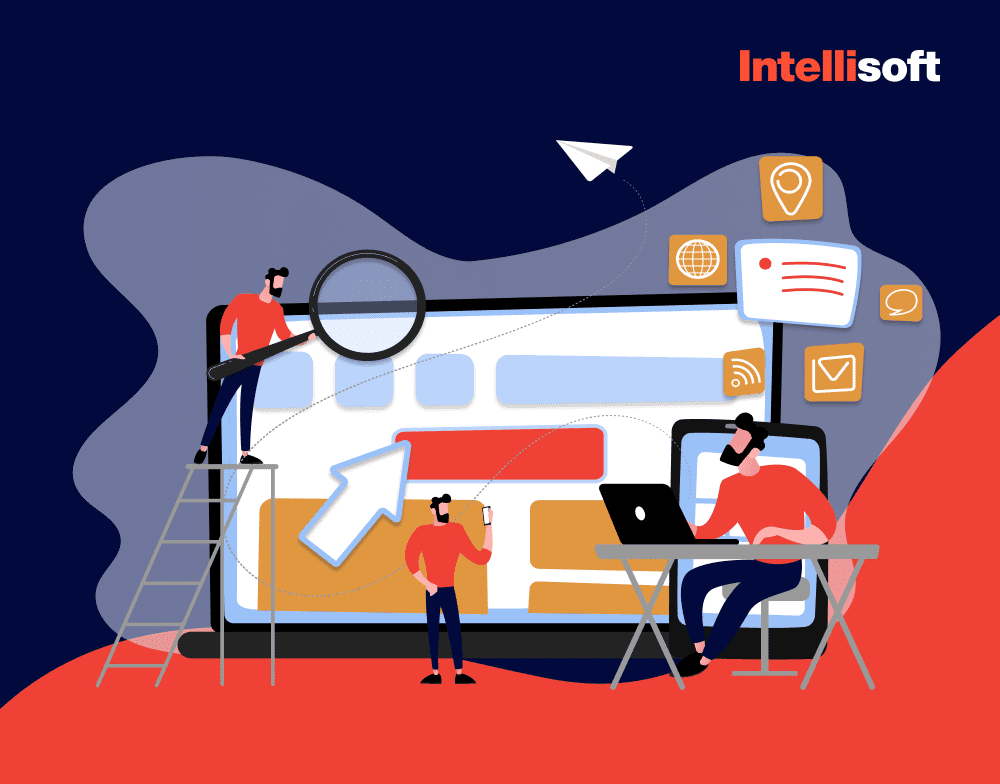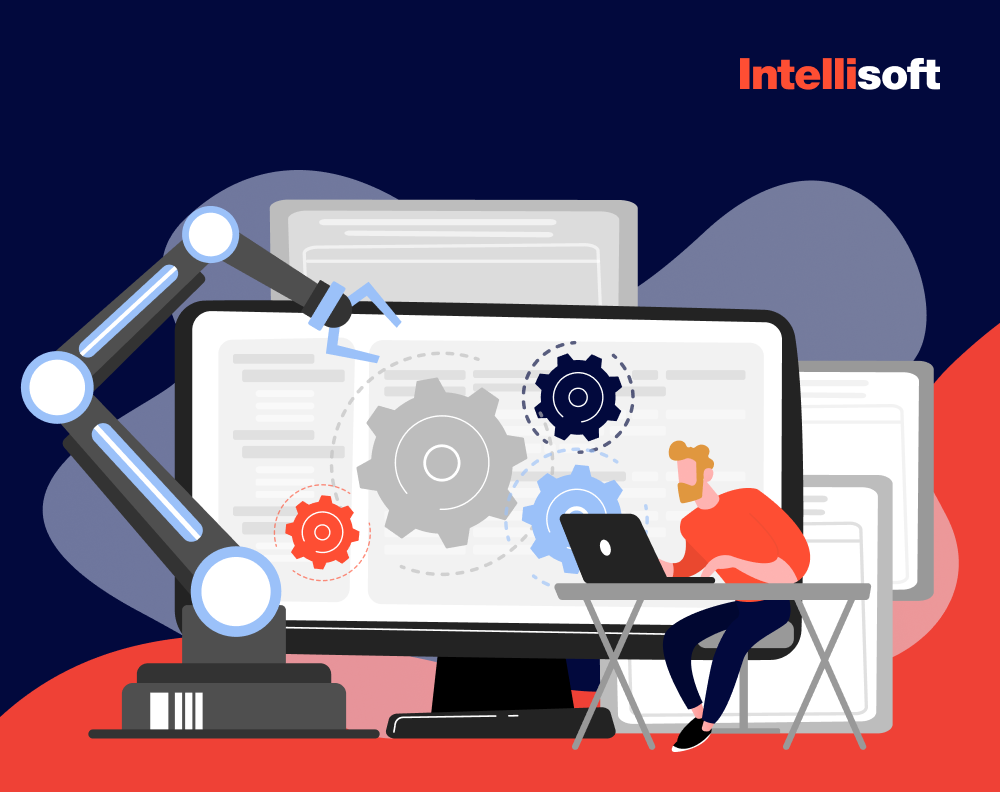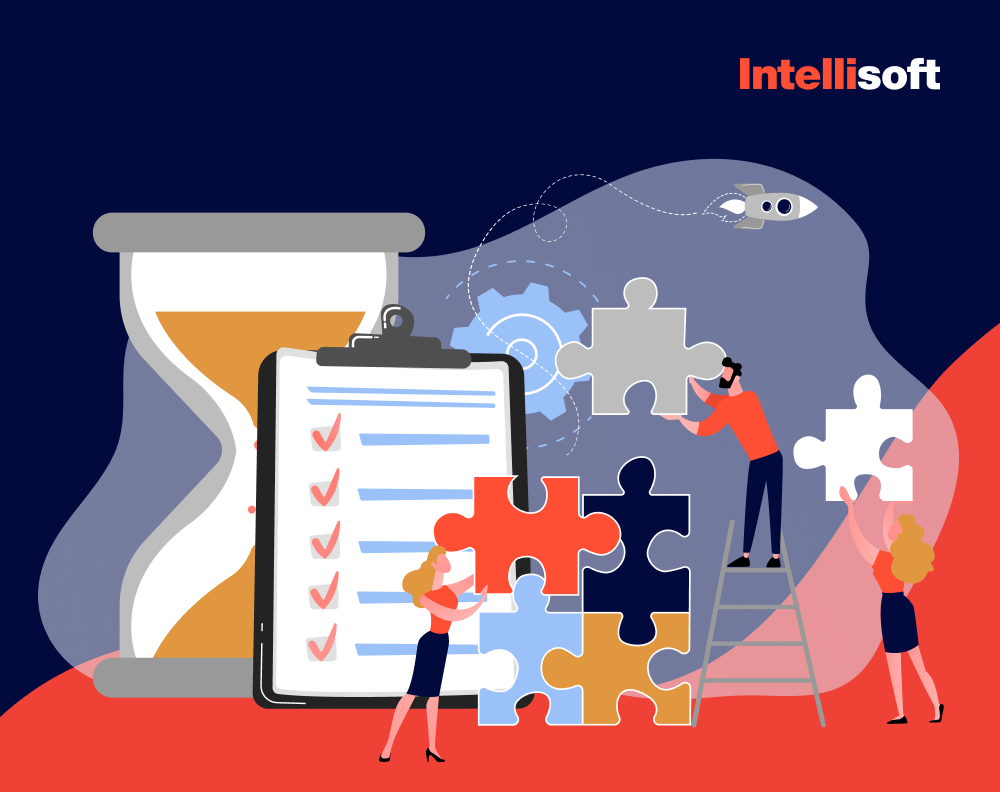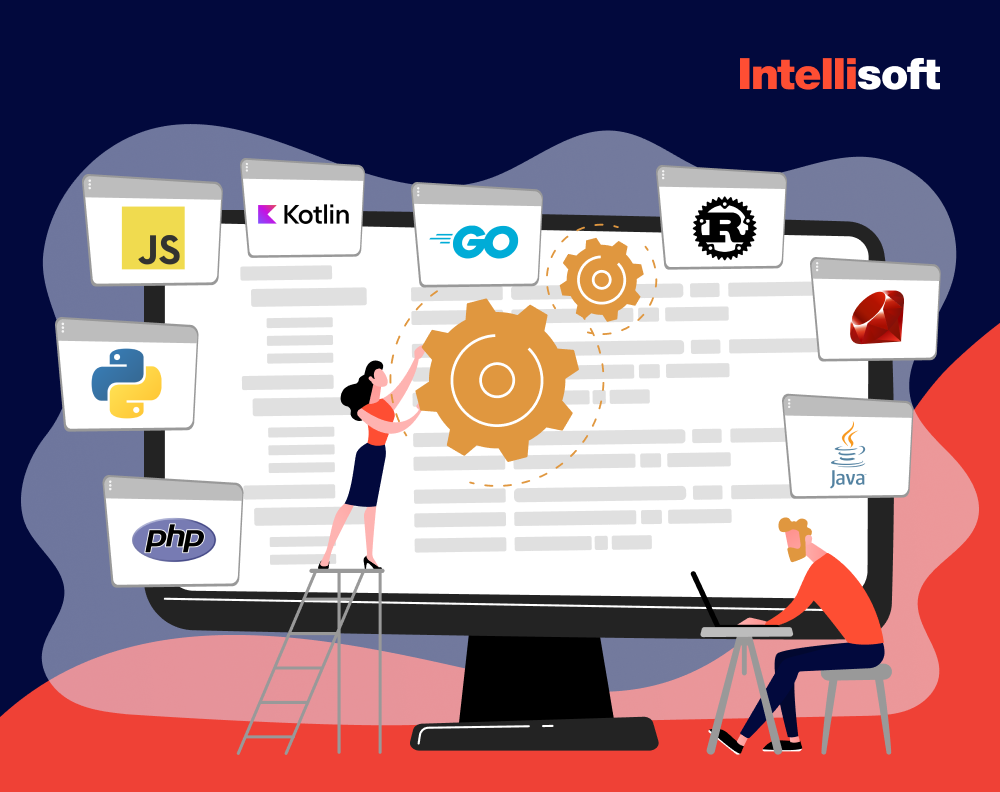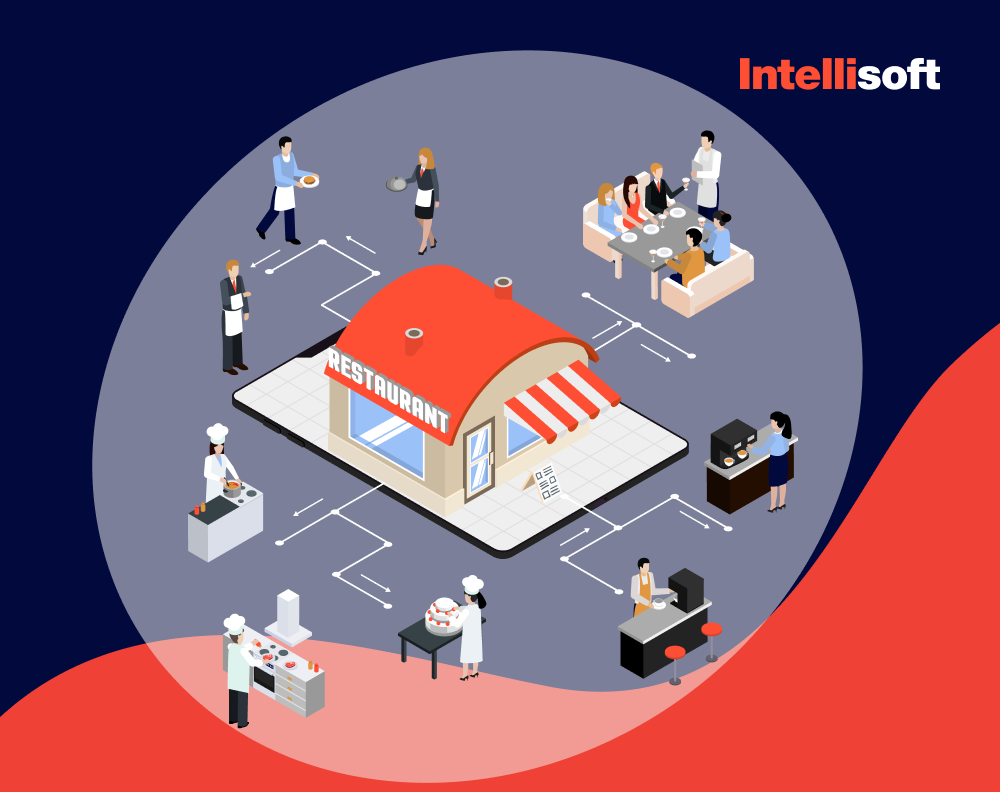Let’s imagine you have an excellent start-up idea in mind – you want to create a live-changing mobile application that will simplify human lives with modern technology. You made the business plan, and now you should choose the platform for your project. Should you go with iOS or Android? Both platforms have their pros and cons and different user demographics. How can you cheat on this step? The answer is simple – you can hire mobile app developers to create a cross-platform application. What does the term “cross-platform” mean?
Developers apply cross-platform frameworks to deliver such projects. Such an application will work on both iOS and Android. Thus, there is no need to create two separate applications to reach a wider audience. IntelliSoft is experienced in building cross-platform applications. After all, we released an app developed with Ionic 3, a cross-platform framework for SpecTec, a client from the logistics industry.
We created this article to explain the advantages of cross-platform app development and the steps required to develop such a project.
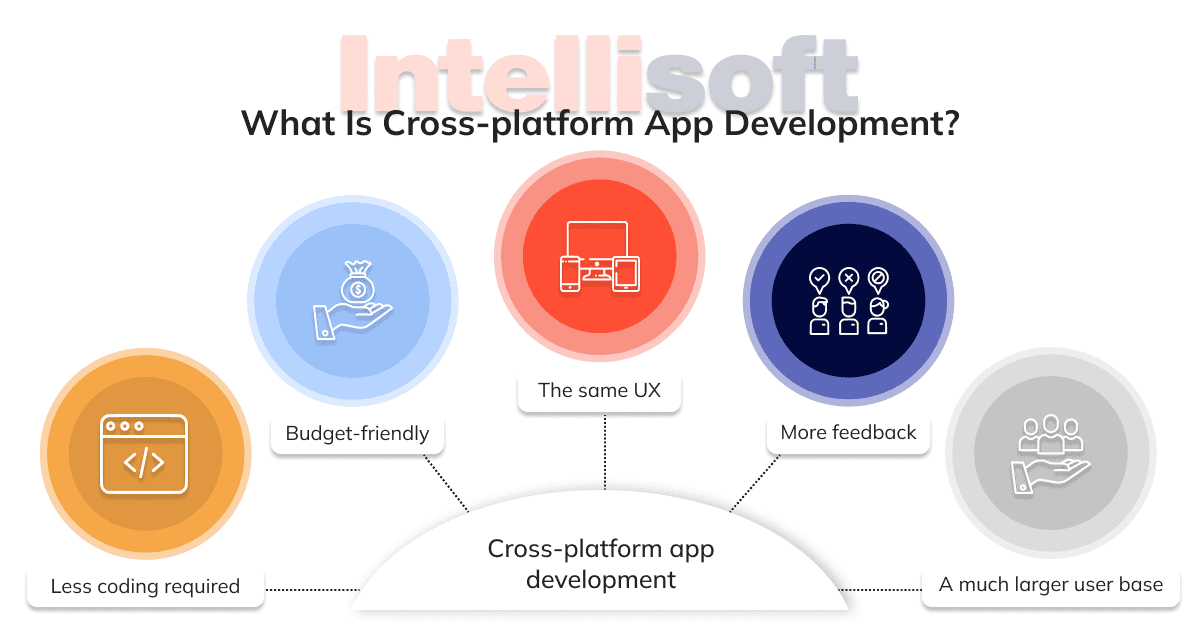
Table of Contents
When Should You Choose Cross-Platform App Development?
A mobile app for businesses is a way to increase sales and audience loyalty. In the apps, customers can make a one-click purchase or promptly contact a manager. For companies, a mobile application is an easy way to remind users about themselves by inserting, for instance, push notifications. They will inform customers about advantageous offers or special promotions. The mobile app can integrate a store’s bonus or discount card, so customers don’t have to carry it around in their physical wallets.
For example, an insurance company can use an application to implement the ability to quickly draw up insurance products and have all the documents at hand. A medical center – to make an appointment with a doctor, accessing medical records. A fitness club – to sign up for workouts and refill your account. Cafe, bar, restaurant – to view the menu. A clothing brand – to fit using augmented reality tools. Doesn’t it sound awesome?”
Kosta Mitrofanskiy – CEO @ IntelliSoft
A technology expert and entrepreneur with 20+ years of experience in the web & software development business.
Determine who your website is designed for. Older people are more likely to use computers, and younger people are more likely to use smartphones. That is obvious.
Statistical sources offer information about the browsers and operating systems used. DCA – Data-Centric Alliance company – conducted a study to determine the popularity of operating systems in certain regions. It was assumed that an average Internet user works with one operating system (OS). Data from five million users of Windows, Android, Mac OS X, Linux, iOS, etc. was used for the study. However, more and more users are having several systems installed at once. That is when cross-platform app development steps into the game.
Cross-platform development is implementing an app that runs on multiple operating systems. This is made possible by using universal code in a framework. Anyway, cross-platform app development is the best option for faster business application, cost reduction, reuse of the same code, etc. Cross-platforming has gained a lot of popularity in the mobile app development industry. Still, the good question is when it is the right time to apply this method. In a nutshell, you should opt for multi-platform solutions if:
- You wish to optimize the time required for the development.
- You would like to have just one codebase for the application logic while taking complete control over user interface elements. Only some cross-platform frameworks like Kotlin Multiplatform Mobile provide this opportunity.
- You have to create a solution for both iOS and Android.
- You want to embrace modern tech that keeps on evolving.
- You need to make a minimum viable product (MVP) quickly. When creating an MVP and testing hypotheses, cross-platform development is way faster to implement.
- When your resources are limited. With cross-platform development, you don’t have to involve two teams of developers for different OSs.
Once you realize that this type of development is right for you, you may wonder what the key tech stack required for such applications is. Several options exist.

React Native
This solution is developed by Facebook to support platforms such as iOS, macOS, Apple tvOS, Android, Android TV, Web, Windows, and UWP. The technology enables you to work with the React library outside the browser to create native apps with full access to system API platforms.
Flutter
The framework was developed by Google and is constantly being updated. While the technology uses the same code for two operating systems, the application does not differ from the native one for the end user. Thus, Flutter combines the benefits of cross-platform and native approaches, which have already been appreciated by many large companies. Alibaba, Philips Hue, Hamilton, Tencent, Grab, Groupon, Dixie Group, Yandex.Drive and other global companies have chosen this technology.
Xamarin
It is an open-source platform for developing high-performance apps for iOS, Android, and Windows with .NET. Xamarin allows you to use at least 90% of the application code without modification across platforms. You can write business logic in one language and still get the interface, behavior, and performance characteristics of the required operating system.
Kotlin Multiplatform Mobile
This option allows you to use a single source code for the subject area logic of Android and iOS apps. Platform-specific code will only be required at certain points (when working with platform-specific APIs or for developing your user interface).
Node.js
It is an open-source, cross-platform runtime environment for crafting server-side and networking apps. Node.js applications are written in JavaScript. The main strength is great cross-platform support. With a little effort, it is possible to check whether your code will run on Windows, Linux, and OSX.
So, which framework for multi-platform solutions to choose from? It depends on multiple factors, such as programming language. Those who know JavaScript and value the support of the large community would benefit from choosing React Native, while Xamarin suits developers who are aware of C++ and need high performance and perks of native instruments.
IntelliSoft has gone a long way to turning into an expert in IT software service development and delivery. We took part in multi platform app development. Our company has many clients, and they appreciate what we do. In particular, here are the pain points IntelliSoft helps them solve:
- Setting clear goals and objectives
- Scope creep
- Budget restrictions and changes
- Lack of communication
- Mismatched team skills
Related readings:
- From Idea to Prototype: Build a Mobile App from Scratch
- How to Build an iOS App for Your Start-up in 2023
- Innovation Roadmap: When to Use a Proof of Concept or Prototype
- Story Point to Hours: Which Estimation Approach to Choose?
- From Concept to Creation: How to Master the Discovery Phase of Product Development
Benefits and Pitfalls of Cross-platform Mobile Apps Development
It is not that easy to choose between various app development types, especially when selecting between cross-platform and native approaches. Knowing the pros and cons will hopefully help you make the right choice.
Pros of Cross-Platform App Development
Universality, time- and cost-effectiveness are undeniable perks of cross-platform app dev. The cross-platform app will be available for installation in both the App Store and Google Play. A cross-platform application will cost less than two separate native versions. Still, let’s look at the benefits closer.
A single code can be reused on several platforms
Code reuse is the reason for the enormous popularity of cross-platforming in mobile technology. A developer can create the same app for another platform using the same code.
Any business can improve its online presence simply by using the same code for another platform. It offers the same software design and features on a different platform.
Cross-platform apps development is cost-effective

Cross-platform application development is also cost-effective. As mentioned above, it offers code reusability, which simply means the same code can be used to create an app on a different platform. Indirectly, the overall cost is reduced by the least amount of work required to create two applications.
Conversely, native app development does not allow developers to reuse code. Thus, native application development is more expensive than mobile app cross platform development.
Less time is required to show up on the market
Obviously, if technologies such as cross-platform enable developers to reuse code, it takes the least amount of time. The total development time depends on the platform, features, frameworks, design, etc. However, cross-platform app development allows developers to create two identical apps for different platforms in the shortest time.
The next question about cross-platform app development is how it takes a minimum amount of time. In native app development, it takes a separate task when creating the same app on different platforms, and since cross-platforming allows for code reuse, it takes half the time to create applications. Experience has shown app development time savings of up to 40% compared to native.
Brand marketing
An entrepreneur or company invests in any service only if it guarantees the best return on investment (ROI). When creating a business app, we first think about which platform is better: Android or iOS. With cross-platform app development, you can appeal to both audiences by embedding source code in the software.
With native app development, creating the same design and user interface for two different applications is difficult. The same look and feel are irrelevant, but it affects the business and the audience. Usually, audiences check both apps, Android and iOS. If somehow they find a difference, then doubts arise. In terms of credibility and marketing goals, cross-platform app development is the best choice.
Ease of support & maintenance
Multi-platform solutions are very easy and advantageous to support since updates and maintenance are cheaper and faster for the company.
Example to Better Understand the Perks
Plus, consider the following – let’s describe the advantages of using the Flutter framework as an example:
- Flutter’s speed is faster than other frameworks; the performance rate – the screen refresh rate is close to 60 FPS (frames per second).
- Flutter allows you to market faster with a finished or minimum viable product (MVP).
- Flutter saves on the staff as a single team is enough.
- Fairly easy to scale in-house development through contractors. It is possible to create a component library for brand apps.
- Unlimited functionality and interface.
- Low costs for bug fixes and updates.
- Every programmer can read the Flutter source code and contribute to its development.
- Flutter uses its own high-performance rendering engine to draw widgets without depending on native elements.
- There is no need to sync the creation of Android and iOS apps and spend extra resources on development management. In the native approach, as a rule, development on one of the platforms is faster.
- Flutter has only one layer written in C/C++, which allows you to achieve performance very close to native.
Google Trends confirms the growing interest in the Flutter framework for development, as seen in the comparison chart below.
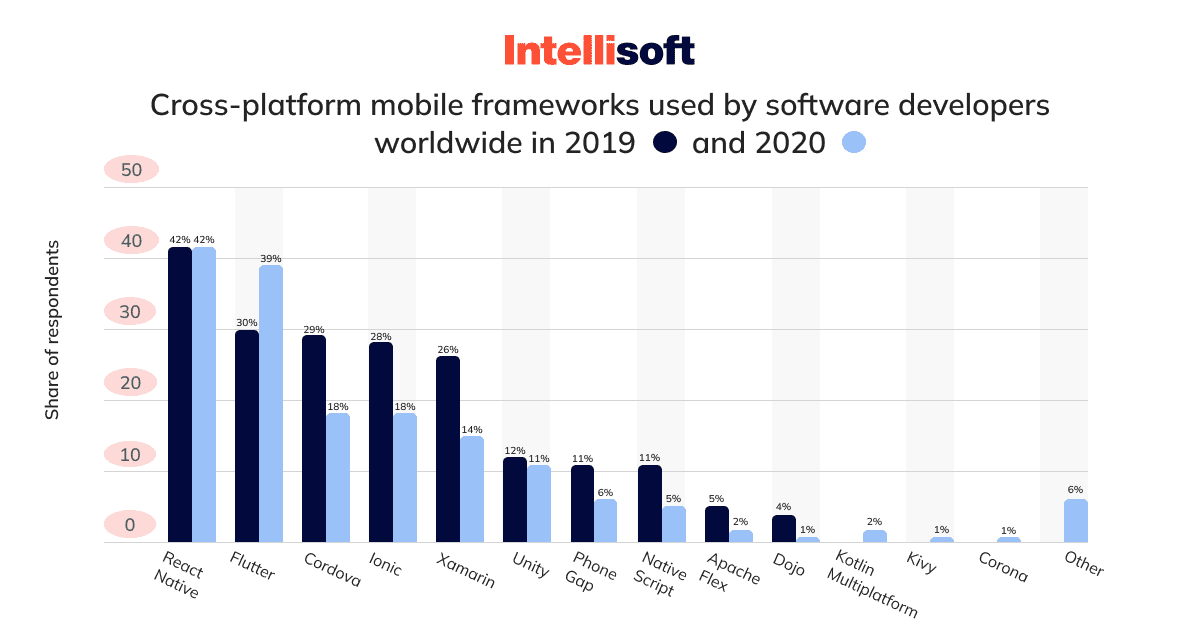
Cons of Cross Platform App Development
Just like anything on our planet, cross-platform mobile development has some pitfalls. Still, they are insignificant if the advantages weigh and mean more to you.
Cross-platform apps aren’t as flexible as native ones
Less flexible functionality is caused by the difference in operating systems. Some functions will be difficult to implement, and the application may not work functionally. In addition, responsiveness suffers.
Worse running speed
Slower running speed is caused by the difference in the interface of the operating systems. A cross-platform application usually runs slower than a native one.
Tougher requirements
In the app stores, particularly the AppStore, the requirements for a cross-platform application will be higher, and moderation will be longer. That is why problems may arise.
P.S. Developing a native application will be faster than developing a cross-platform one. This is because mobile app cross platform development requires different approaches within the same code and testing, which increases development time. Creating two native apps will be faster but more expensive to develop and maintain. The higher speed and cost can be explained by the fact that the Android and iOS versions are developed simultaneously by different developers who have knowledge of their OS.
Is a Cross-Platform Approach Suitable for the Development of Your App?
This question appears naturally, but there is no definite answer. It depends on your goals. Start with statistics. There are more than eight billion smartphones in the world. Of those, about three billion are running Android, and 900 million people prefer iOS. According to the data, Android and iOS now account for a combined 99% of the worldwide smartphone operating systems. It seems that, in this case, it is more profitable to develop a native application for Android. However, in this case, companies will lose the share that belongs to the iOS audience. At first, the absence of the app will be a minor disadvantage for users, but sooner or later, they will leave for competitors. At the same time, it is longer and more expensive to create two separate native apps for Android and iOS. So, cross platform app development is a choice when:
- You have restricted resources and time
- You would like to show up on the market ASAP
- Your main objective is to reach out to a broader audience
- You have a site to wrap up into a mobile solution without investing plenty of money
- Your future software should not have complex graphics or features
- You hesitate whether the product will be successful
- You want your software to access all device’s resources hassle-free
- You would like your app to be highly responsive and make the most of the device’s hardware
Anyway, it’s still an experienced developer who can weigh all pros and cons of cross platform app development for every case. If you are at a crossroads, don’t hesitate to ask experts from IntelliSoft for a piece of advice or even full-fledged development. You can learn how we develop cross-platform apps in detail at any moment.
#1 – Make Your UI Interesting
The user interface should be as clear as possible for most people. If a person does not understand how to use an application or website after pressing various buttons randomly for a few seconds, they will be disappointed and probably leave the resource.
Trying to put as many categories, menus, buttons, and so on in the interface as possible will do harm. An interface that is too cluttered is a big obstacle to user comprehension. Anything that can be described in one phrase should not be described in three. Superfluous elements and subcategories on the home page are also senseless.
Slow interface loading will irritate and discourage the user, causing them to dislike the resource increasingly. Make sure the loading speed is optimal for its comfortable usage.
Functionality and usability are necessary, but there is also such a concept as “beautiful/not beautiful.” Any user will be much more pleasant to deal with an interface that, on top of everything else, is pleasing to the eye. The interface should talk to your customers, so the way it functions and looks matters.
#2 – Test Your App as Much as You Can
Testing is an essential stage of mobile app development. The cost of an error in releasing a mobile app is high. Apps go to Google Play within hours and Appstore within a few weeks. It is unknown how long users will be updated. Bugs cause a lot of adverse reactions, with users leaving low ratings and negative feedback. New users don’t install the app after seeing low grades.
Mobile testing is a complicated process: dozens of various screen resolutions, hardware differences, multiple versions of operating systems, different types of Internet connections, sudden connection failures, etc.
That is why you should better have more people working in your testing department or just leave this stage to professionals from IntelliSoft. Mind the following types of mobile app testing: Functional Testing, Performance Testing, Memory Leakage Testing, Interrupt Testing, Usability Testing, Installation Testing, Security Testing, Compatibility Testing, and Recover-Ability Testing.
#3 – Create a Platform-Centric Design
The first step to creating a design attractive for users is to study the customer’s personality extensively. Do you know who your target users are? What do they like? What do they prefer? What are their daily tasks, and what do they need to do? What are their goals, dreams, and desires?
Once you have gathered all the necessary information about your target audience and have already defined who your user is (that is, created their buyer persona), it is quite easy to see an image of such a person just by closing your eyes and resorting to your own imagination. What is remarkable, you even know about their needs and desires.
Now you need to predict the possible user behavior scenarios regarding interaction with the mobile app. In what context will they use it? Where and when? What problems can they encounter, and in what cases? It is best to predict both the best and worst user scenarios.
The last step is to create a prototype based on what you have learned about the target users and their problems and behavioral scenarios. Now it is necessary to take into account all possible options in your working prototype so that it looks like the final product.
#4 – Use Reliable Modules
Time is money, and not only. You might be short on time when developing and launching an app. That’s why we propose you use special modules to speed up the processes. Try to conduct research beforehand and use modules that you can rely on.
#5 – Focus on the User
Once you learn enough about your potential customers, it should be easier to identify and understand their problems. So, how do you determine what challenges/problems they face daily? Generally speaking, there are no small or large problems per se in research. There are only major issues and their symptoms. Regardless of the size and significance of the problem, if it exists and your target audience faces it every day, you need to develop a solution that will surely help. This is one of the most important things that makes any product successful, and the brand becomes adored by the target audience.
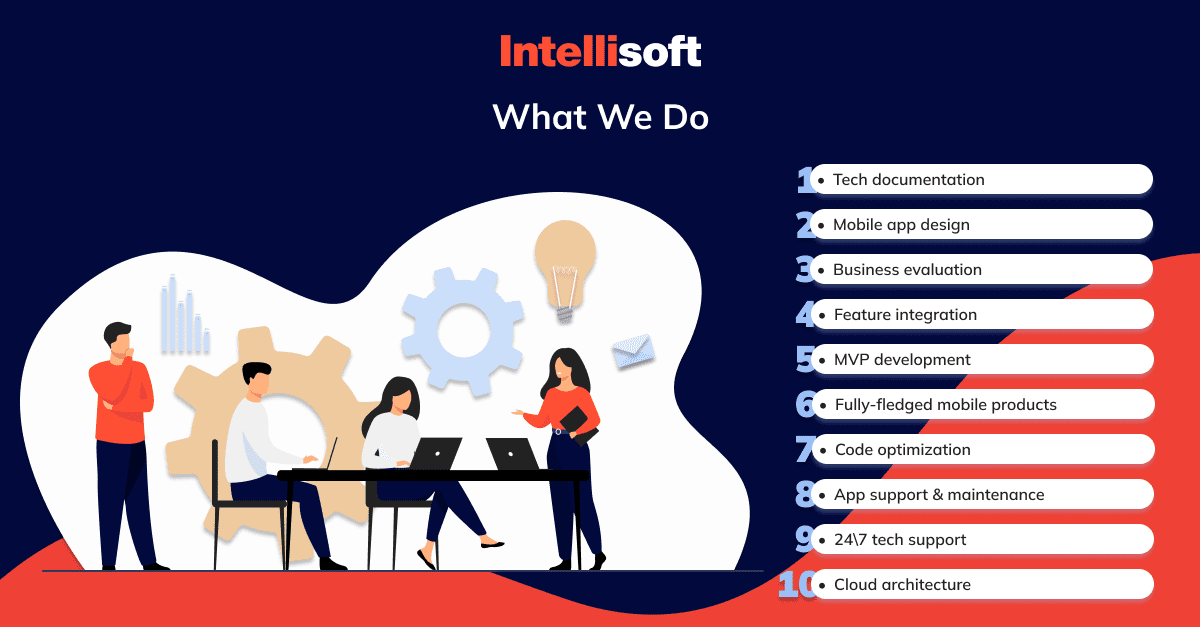
What We Do
IntelliSoft offers a range of services to develop your mobile application from scratch without missing a thing. No need to worry about any stage of the process.
- Tech documentation
Get rid of your headache as we prepare budget plans, risk management reports, delivery reports, and other documents.
- Mobile app design
Our team knows how to create apps tailored to your client’s requirements and expectations. We will help you make it attractive to your target market. Do not worry – we have access to the necessary tools and resources for creating such a design. Our experts help to utilize UI/UX Design, Product Discovery & Research, and Branding.
- Business evaluation
Our company helps conduct a broad relevant study and evaluate your business and industry overall. Moreover, we even offer workshops with your employees and end-users.
- Feature integration
Our services in this category include project road mapping, code control & reports, application programming interface (API) development, security standards, and installation of third-party platforms.
- MVP development
MVP development falls under our expertise as well. This service from IntelliSoft includes full project control, support, & maintenance, counseling, and in-house staff onboarding.
- Fully-fledged mobile products
Our customers easily solve multiple problems an end-user may challenge shortly. From the unique idea(s) to their launch and support, you can count on us. We know how to boost user experience and cut expenses.
- Code optimization
Our team can assist with optimizing and changing codes to boost efficiency and quality. After our expert check, we guarantee the software will consume less memory, perform better, and run much quicker.
IntelliSoft can utilize flexible MCC to deliver rapid apps of premium quality to different mobile devices running various operating systems.
- App support & maintenance
We do more than develop a solution from scratch. Our experts will support the product even after its launch. We take care of OS/API updates, application scaling, and DevOps.
- 24\7 tech support
We have a highly responsive customer support team. You can book a free consultation to learn more about our services.
What You Get
We offer a series of benefits to boost business efficiency in different industries.
- Expanded distribution
Enhance your business reach fast and simply. We help to generate higher revenues.
- Increased engagement
Higher retention rates due to better user engagement and powerful mobile marketing.
- Optimized business processes
Collect information necessary to detect opportunities and maximize productivity.
Once you are ready to obtain help with your project on our website, let us know the details. We are here to answer any questions you may have. Regarding the price, you can estimate the rate before our cooperation starts.






